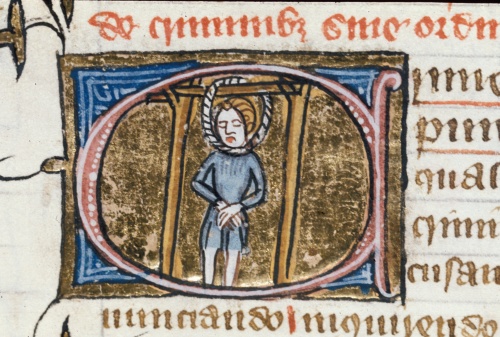Blog
What was William Cragh hanged on?

Two words are used by the witnesses to describe the scaffold on which William Cragh was hanged, both of which can mean gallows or gibbet. However, ‘furcis’ and ‘patibulum’ are also commonly translated as being a two pronged fork, yoke, or farm implement made from wood, a prop, or a y shaped frame used for carrying things. This question over the translation has engaged me for months, and I have been trying to read up on what a medieval gallows would have looked like.
The breakthrough came a week ago at our team meeting at Kings College when Paul was showing us how the Early English Laws website digital editions worked - and there it was. The header image on the home page had an image of a man being hanged on a gallows with two uprights, both ‘y’ shaped or forked.
This then explained the possible meanings of the words ‘furcas’ and ‘patibulum’. These common farming implements were evidently put to an alternative use when needed in locations where there was not a permanent scaffold in place as the uprights for a gallows, the structure being completed with the frequently referred to cross-beam.
But the picture explained even more of the details of the hanging, as reported by the witnesses. Firstly, after the cross beam breaks and William and Traharn are hanged for a second time, the witnesses describe how they are strung up again, one from each of the remaining arms. If the tops of the gallow’s uprights were forked as this illustrations shows, then it would have been both logical and practical for them to be hanged from these.
Secondly, the nature of Traharn’s hanging, (which was reportedly the reason for the beam breaking,) is also made clearer. The witnesses say that the rope by which he was hanged was thrown over the cross beam, and he was heaved up sharply. The beam then broke because he was apparently a large and heavy man. While I did not doubt that Traharn could have been hanged in this way, seeing the manuscript illustration made it clearer that this was indeed a standard way of doing so.
A further search for ‘gallows’ in the British Library’s manuscript image database has corroborated this structure, which is excellent news, not least because I have at last been able to settle on my translation of ‘furcas’ as ‘gallows’ and ‘patibulum’ as ‘gibbet’.

Could this image of a criminal being hanged taken from BL MS Royal 6 EVI fol.444 be what our William Cragh was hanged on?
Share on Twitter Share on Facebook



